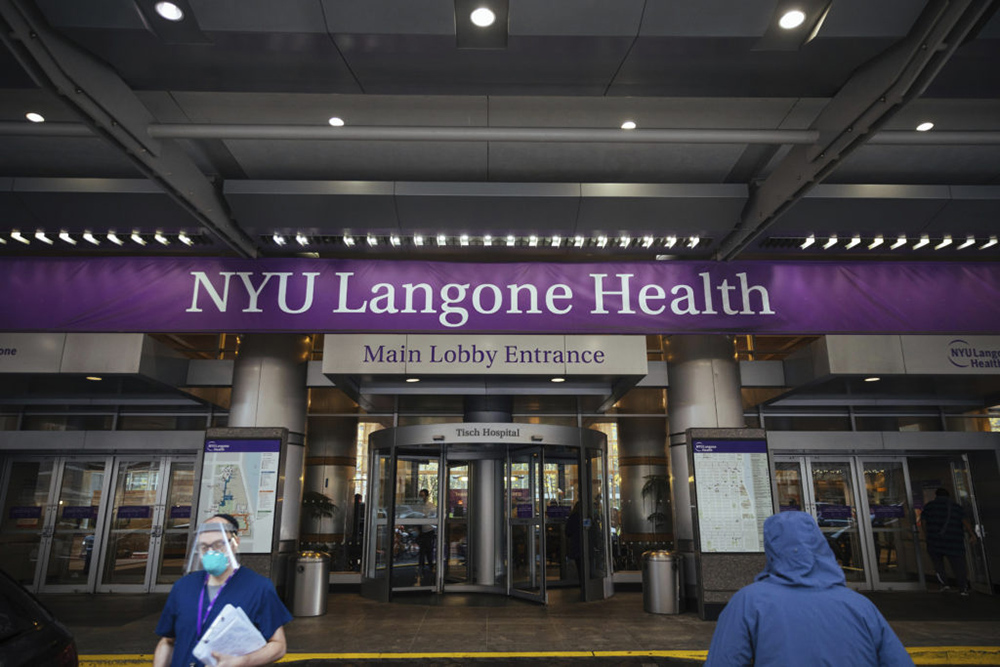|
Getting your Trinity Audio player ready...
|
How One Brooklyn Man’s Health Crisis Highlights Growing Risk of Strokes Among Younger Adults
Edited by: TJVNews.com
Michael Curcio, a 47-year-old from Brooklyn’s Bay Ridge neighborhood, thought he had his health well under control. As a stay-at-home dad and freelance artist, he maintained an active lifestyle that included running, weightlifting, and sparring. However, in December of last year, his health took an unexpected and dramatic turn, revealing that even seemingly healthy individuals can be vulnerable to a life-altering stroke. NYU Langone has shared Michael’s journey as a reminder that strokes are increasingly affecting younger people and to underscore the importance of stroke awareness and prevention.
Michael recalls feeling the onset of a headache as he drove home one day, followed by a startling visual distortion that blurred the upper portion of his vision as if he were looking at a pixelated image. Within minutes, he collapsed on his kitchen floor, overwhelmed by dizziness, weakness, and a chilling numbness that spread from his stomach to his leg, arm, and face. “I couldn’t lift my arm. I couldn’t lift my leg,” he recalls, prompting him to tell his wife, Jeannie, to “Call 911.”
Due to Jeannie’s quick thinking and the rapid response of emergency medical services, Michael was rushed to the Emergency Department at NYU Langone Hospital—Brooklyn, where he received immediate care. Dr. Aaron S. Lord, chief of neurology at NYU Langone Hospital—Brooklyn, emphasized that “when you have a stroke, every minute counts,” and Michael’s case is a testament to how early intervention can improve outcomes for stroke patients.
Understanding Stroke Types and Causes
According to NYU Langone, Michael experienced an ischemic stroke, which occurs when a blood vessel supplying the brain becomes blocked. Dr. Lord explains that ischemic strokes account for 87 percent of all stroke cases, and they are the most common type among younger adults. In Michael’s case, the cause was a partial tear in the wall of his carotid artery, known as a dissection. This type of tear creates a blockage that restricts blood flow to the brain, triggering a stroke. Dissections like Michael’s can happen spontaneously, without any apparent reason, or they may be linked to traumatic neck injuries, specific medical conditions, or family history.
Dr. Brandon Giglio, director of vascular neurology at NYU Langone Hospital—Brooklyn, highlighted that while stroke can strike anyone, the average age of stroke patients in the U.S. is decreasing. For the majority of young adults, stroke risk is tied to lifestyle factors commonly associated with heart disease: high blood pressure, high cholesterol, obesity, and type 2 diabetes. Dr. Giglio notes that lifestyle choices are increasingly putting people in their 20s, 30s, and 40s at risk. He attributes this shift to a growing prevalence of sedentary habits and unhealthy diets, alongside other risk factors such as smoking, excessive alcohol use, and substance abuse.

Sedentary Lifestyles and Unhealthy Diets: The New Stroke Risk Factors
NYU Langone reported that one major contributor to stroke risk in young adults is the rise of sedentary lifestyles. Dr. Giglio points out that the increase in remote work means people are often moving less during the day, going directly from their beds to their desks without even minimal physical activity like commuting or climbing stairs. This drop in daily movement can contribute to a range of health issues, from weight gain to elevated blood pressure, both of which can increase the risk of stroke.
In addition to inactivity, diet is another critical factor. Many people today rely on fast food and processed meals that are high in sodium, sugars, and unhealthy fats. Studies have linked diets heavy in processed foods to conditions such as high blood pressure, obesity, and diabetes—all of which can increase the likelihood of experiencing a stroke. Dr. Giglio explained that being mindful of food choices, even at a young age, could significantly reduce stroke risk and improve overall health outcomes.
Smoking, Vaping, and Substance Use: Compounding the Risk
Alongside inactivity and diet, NYU Langone stresses that smoking, vaping, excessive alcohol consumption, and drug use are all behaviors that elevate stroke risk. Smoking and vaping, for example, can damage blood vessels and elevate blood pressure, while excess alcohol can lead to hypertension and other conditions that contribute to stroke. Dr. Giglio advises that people consider these factors when assessing their personal stroke risk and make lifestyle adjustments that could have lasting health benefits.
Managing Stroke Risk: A Lifelong Commitment
Michael Curcio’s experience serves as a stark reminder that stroke can affect anyone, even those who appear to be in excellent health. The medical team at NYU Langone encourages individuals of all ages to consider stroke prevention as part of a comprehensive health strategy. This includes regular physical activity, a balanced diet rich in whole foods, and moderation in alcohol consumption. For those who smoke or vape, quitting can have a profound impact on reducing stroke risk and improving vascular health.
Dr. Giglio and Dr. Lord emphasize that awareness of stroke symptoms and risk factors is crucial, as early intervention is key to minimizing damage and promoting recovery. They also highlight the importance of monitoring and managing health conditions, especially those associated with cardiovascular health, as these can lower the risk of stroke.
Since his stroke, Michael has worked with NYU Langone’s specialists to manage his health and regain his strength. He is undergoing physical therapy and attending follow-up appointments with vascular specialists to ensure his long-term well-being. As part of his recovery, he is now closely monitoring his blood sugar levels, as he was on the cusp of prediabetes at the time of his stroke. NYU Langone’s team has helped Michael establish a comprehensive care plan, addressing both his physical and preventive health needs.
“When people heard that I had a stroke, everyone was in shock,” Michael says. “Most people know I take really good care of myself, and I said, ‘Listen, it can happen to anybody, no matter what kind of shape you’re in.’” His story is a wake-up call to younger adults who may believe they are immune to serious health issues. As Joanna Marmo, BSN, RN, SCRN, stroke program coordinator at NYU Langone, urges, “Annual checkups and screenings for underlying conditions are crucial for managing stroke risk, even in young, fit adults.”
Recognizing the Signs of Stroke: The BE FAST Method
One of the most crucial parts of Michael’s story is his awareness of the signs of stroke, which enabled him to seek help immediately. NYU Langone is committed to educating the public on these symptoms to ensure that anyone experiencing a stroke can get the help they need in time. Stroke experts at NYU Langone recommend remembering the acronym BE FAST to recognize stroke symptoms quickly:
Balance: Sudden loss of balance or coordination may be a stroke warning.
Eyes: Vision problems, like Michael’s pixelated vision, can be an early indicator.
Face: Facial drooping, often visible when someone smiles, is a common stroke symptom.
Arms: Weakness or inability to lift one arm may signal a stroke.
Speech: Slurred or garbled speech is a red flag.
Time: When any of these symptoms appear, time is of the essence. Immediate medical intervention is critical.
Dr. Giglio emphasizes, “If you get any of these symptoms, BE FAST.” Recognizing the signs and acting quickly can mean the difference between full recovery and lasting impairment.
Prevention Is Key: Annual Checkups and Healthy Habits
In addition to recognizing stroke symptoms, NYU Langone encourages young adults to make preventive care a priority. Annual checkups are essential for monitoring blood pressure, cholesterol, blood sugar, and other risk factors that may predispose someone to stroke. By identifying and managing these risk factors early, young adults can greatly reduce their chances of experiencing a stroke.
Joanna Marmo emphasizes the importance of preventive health, explaining that routine screenings can catch conditions before they become serious. “An annual checkup allows us to identify underlying risks early and work on managing them,” she says. This preventive approach, which includes promoting an active lifestyle and healthy eating, can be a powerful tool in combating the rise of stroke among younger adults.
Moving Forward: Michael’s Message of Awareness
Michael Curcio’s story, shared by NYU Langone, is a powerful reminder that stroke can strike anyone, regardless of age or fitness level. With the help of NYU Langone’s dedicated team, Michael is on a steady path to recovery and is now spreading a message of awareness. His experience has shown him the value of both quick action and preventive health, and he hopes others will learn from his story.
His advice to younger adults is simple: “Even if you don’t think you can have a stroke, go get yourself checked out right away.” NYU Langone’s medical team echoes this sentiment, urging everyone to prioritize their health and stay informed about the signs and risks of stroke. Through education, regular checkups, and a commitment to healthy living, younger adults can take important steps to protect themselves against this increasingly common health crisis.





